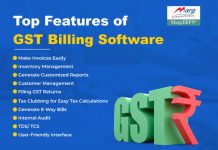In India, Goods and Services Tax (GST) has simplified the process of tax filing and collection. GSTR-4 is one such return that is filed by Composition taxpayers. In this blog, we will take a closer look at GSTR-4 and understand its features and benefits.
What is GSTR-4?
GSTR-4 is a return form that is filed by taxpayers who have opted for the Composition Scheme under GST. Composition Scheme is a scheme that enables small taxpayers to pay tax at a lower rate and reduces their compliance burden. It is available to businesses with an annual turnover of up to Rs 1.5 crore.
Who should file GSTR-4?
GSTR-4 should be filed by taxpayers who have opted for the Composition Scheme. These taxpayers are required to file GSTR-4 once every quarter, i.e., on a quarterly basis. The due date for filing GSTR-4 is the 18th of the month succeeding the quarter. For example, for the quarter ending June, the due date for filing GSTR-4 is July 18th.
What are the components of GSTR-4?
GSTR-4 consists of the following components:
- Business details: This includes the name, address, and GSTIN of the taxpayer.
- Details of outward supplies: This includes details of all the supplies made by the taxpayer during the quarter. It includes details such as the invoice number, date, value, and GST rate.
- Details of inward supplies: This includes details of all the purchases made by the taxpayer during the quarter. It includes details such as the invoice number, date, value, and GST rate.
- Payment of tax: The taxpayer is required to pay tax on the supplies made during the quarter. The tax payable can be paid through the GST portal.
What are the benefits of filing GSTR-4?
The following are the benefits of filing GSTR-4:
- Easy compliance: GSTR-4 is a simplified return that reduces the compliance burden of small taxpayers who have opted for the Composition Scheme.
- Lower tax rate: Composition Scheme enables small taxpayers to pay tax at a lower rate, which reduces their tax liability.
- No need to maintain detailed records: Taxpayers who have opted for the Composition Scheme are not required to maintain detailed records, which further reduces their compliance burden.
What is the Composition Scheme?
The Composition Scheme is a scheme that is available to small taxpayers whose annual turnover is up to Rs 1.5 crore. Under this scheme, taxpayers can pay tax at a lower rate and reduce their compliance burden. Taxpayers who have opted for the Composition Scheme are required to file GSTR-4 once every quarter.
How to file GSTR-4?
GSTR-4 can be filed online through the GST portal. Taxpayers are required to log in to the GST portal and navigate to the GSTR-4 section. They are then required to enter the details of outward supplies, inward supplies, and payment of tax. Once all the details have been entered, taxpayers can preview the return and file it.
Consequences of not filing GSTR-4?
If a taxpayer fails to file GSTR-4 within the due date, they may be liable to pay a late fee. The late fee for not filing GSTR-4 is Rs 200 per day (Rs 100 as SGST and Rs 100 as CGST) until the return is filed. Additionally, the taxpayer may be required to pay interest on the tax payable.
Differences between GSTR-4 and GSTR-3B?
GSTR-4 is a return that is filed by taxpayers who have opted for the Composition Scheme, while GSTR-3B is a return that is filed by regular taxpayers. The main difference between GSTR-4 and GSTR-3B is that GSTR-4 is filed once every quarter, while GSTR-3B is filed once every month. Additionally, GSTR-4 is a simplified return that requires less information compared to GSTR-3B.
Benefits of the Composition Scheme?
The Composition Scheme has several benefits for small taxpayers. It enables them to pay tax at a lower rate and reduce their compliance burden. Additionally, taxpayers who have opted for the Composition Scheme are not required to maintain detailed records, which further reduces their compliance burden. The Composition Scheme is an excellent option for small taxpayers who want to comply with GST regulations without too much hassle.
In conclusion
GSTR-4 is a return that is filed by taxpayers who have opted for the Composition Scheme. It is a simplified return that requires less information compared to other returns. Taxpayers who have opted for the Composition Scheme can pay tax at a lower rate and reduce their compliance burden. By filing GSTR-4 on time, taxpayers can avoid penalties and interest on the tax payable.
Here are some FAQs related to GSTR-4:
Who can file GSTR-4?
GSTR-4 can be filed by taxpayers who have opted for the Composition Scheme under GST. It is available to businesses with an annual turnover of up to Rs 1.5 crore.
What is the due date for filing GSTR-4?
The due date for filing GSTR-4 is the 18th of the month succeeding the quarter. For example, for the quarter ending June, the due date for filing GSTR-4 is July 18th.
Is it mandatory to file GSTR-4?
Yes, it is mandatory for taxpayers who have opted for the Composition Scheme to file GSTR-4. Failure to file GSTR-4 within the due date may attract a late fee and interest on the tax payable.
Can I revise GSTR-4?
No, taxpayers cannot revise GSTR-4 once it has been filed. However, they can make corrections to the details of outward supplies and inward supplies in the next quarter’s return.
What happens if I don’t file GSTR-4?
If a taxpayer fails to file GSTR-4 within the due date, they may be liable to pay a late fee of Rs 200 per day (Rs 100 as SGST and Rs 100 as CGST) until the return is filed. Additionally, the taxpayer may be required to pay interest on the tax payable.
Can I claim input tax credit (ITC) under the Composition Scheme?
No, taxpayers who have opted for the Composition Scheme are not eligible to claim ITC on the purchases made by them. They are required to pay tax on the supplies made by them at a lower rate.
What are the consequences of incorrect information in GSTR-4?
If a taxpayer provides incorrect information in GSTR-4, it may lead to a mismatch between the details of outward supplies and inward supplies. This may result in an inquiry by the tax authorities and may attract penalties and interest on the tax payable. It is, therefore, important to ensure that the information provided in GSTR-4 is accurate and complete.








